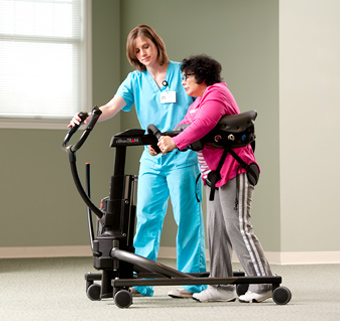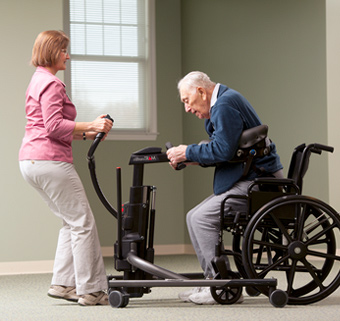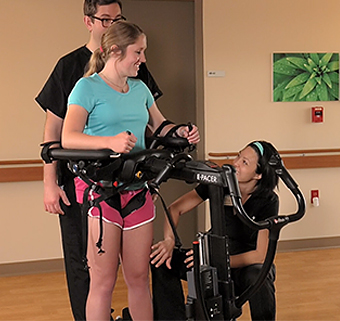Standing with the E-Pacer
Watch: E-Pacer Introduction and Walking with the E-Pacer.
For patients with poor sitting balance who cannot safely stand, initial sessions will focus mainly on standing and posture, with two people assisting.
Before starting the session, make sure a fully charged battery is in the battery box.
Charge the battery overnight at least once a week. Do not start a therapy session with a battery that is on orange or red.
The scale will tell you how much weight is being taken off a patient’s feet.
The scale has a separate set of batteries. Replacement double-A batteries are stocked in each nursing storage area.
In the patient’s room, before transfer into the wheelchair, place the pelvic support gray side up and flat side back on the seat. The V-shaped inguinal straps should be in the front.
Move the straps on the back of the pelvic support out to the sides. Allow the inguinal straps to hang down over the front of the wheelchair.
Transfer the patient to the wheelchair.
Adjust the inguinal straps between the patient’s legs, making sure that they are not twisted.
Transport the patient to the therapy gym.
Remove the wheelchair footrests and armrests. Have a second person ensure that the patient is secure.
Spread the base so that it fits around the wheelchair wheels.
Adjust the body support height until it is one to two inches above a patient’s thighs.
Lift the patient’s weak arm, and then back the E-Pacer up until the patient’s chest is resting on the chest support.
Support the patient’s trunk as needed to facilitate an upright posture.
Position the armrests close to the patient’s sides and directly under his shoulders so he can optimally depress his scapulae and press down through his elbows.
If the armrests are too high, and the patient’s elbows are out to the sides, he might experience shoulder discomfort and difficulty in weight bearing.
You may need to flip the armrest base… or move it to the opposite side to achieve the correct position.
Place the patient’s weaker arm on the arm platform and fasten the strap. Have her place her own stronger arm into the other arm platform.
Buckle the back of the trunk support.
Tighten the strap until it feels secure, but not too tight. The patient should be able to inhale without restriction.
There should be at least two inches of space between the top of the body support system and the armpit.
Bring the silver rings at the end of the posterior strap forward and hook them onto the colored clips on the body support.
For most patients with hemiplegia, either the red or the yellow hooks will work best.
Tighten the straps until there is minimal slack.
Wrap the inguinal straps around the thighs and across the rear straps, and connect them to the blue or gray clips. Tighten the straps.
When both the body support system and pelvic support are secure, the patient is ready to be lifted.
Grasp the handles on the front of the E-Pacer and use the switch on the right handlebar to operate the lift.
Take two to three steps backwards as you lift, pulling the patient forward, nose over knees.
An assistant should steady the patient and adjust straps as necessary, since the fit may change as the patient rises to a standing position.
If the chest support is too high under the patient’s arms, lower the body support and tighten the pelvic harness straps.
When the patient is standing, the top of the armrests should line up with her lower ribs.
Once the patient is standing, lock the front brakes.
Have the assistant pull the wheelchair back and out of the way.
Use the expansion handle to bring the base legs close together and lock the rear casters.
Have an assistant place a mirror in front of the patient. This allows her to see if she is shifting away from midline, and correct postural errors.
Position the patient’s feet shoulder width apart and place a stool to the patient’s weak side.
Facilitate knee extension with one hand while facilitating hip extension with the other.
The assistant, standing behind the patient, can facilitate back extension through the shoulders with verbal and tactile cues.
Trial standing tall for 1 minute, with as much physical assistance as necessary to maintain correct posture.
After a minute, give the patient a chance to rest. Stand for another minute when the patient has strength to extend.
Tap or squeeze the quads as necessary to encourage extension.
Cue the patient to push through her forearms, lift her head high and bring her shoulders back.
Encourage patient to make eye contact with herself in the mirror and avoid looking at the floor. Repeat as tolerated until she is fatigued and needs to sit back down in the chair.
As a patient begins to engage quad extension and hip extension independently, reduce the facilitation from the therapist, only assisting when the knee buckles.
The amount of support from the E-Pacer itself can also be reduced as tolerated, by lowering the body support slightly.
Consider using E-stim to the quadriceps to facilitate knee extension, or using an AFO to prevent knee buckling. Either of these treatment options works well in combination with the E-Pacer.
To return the patient to the wheelchair, unlock the rear brakes.
Stabilize the E-Pacer while an assistant unlocks the front casters. Use the expansion handle to spread the base legs and bring the wheelchair behind the patient.
Make sure the patient’s feet are clear of the base legs. Push the E-Pacer forward as you lower the patient into the wheelchair, to ensure that her hips are in full contact with the backrest.
Once the patient is secure in the chair, disconnect the walking saddle from the colored clips, release the body support strap, and disengage the patient’s arms from the forearm supports.
Move the E-Pacer away from the patient and return the wheelchair armrests to their locked position.
Once a patient is able to stand for five minutes at a time in an upright posture without excessive fatigue, she may be ready to transition to gait training.




